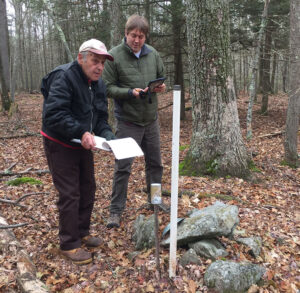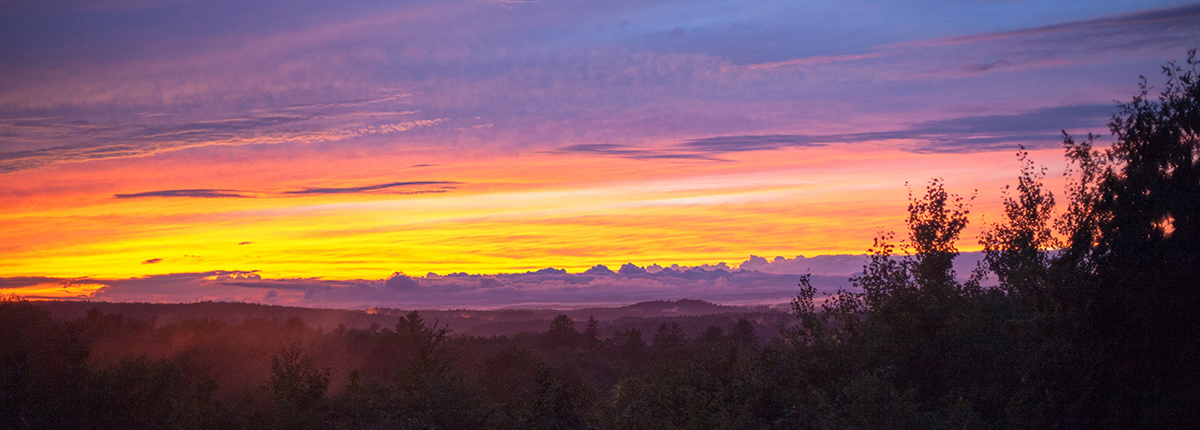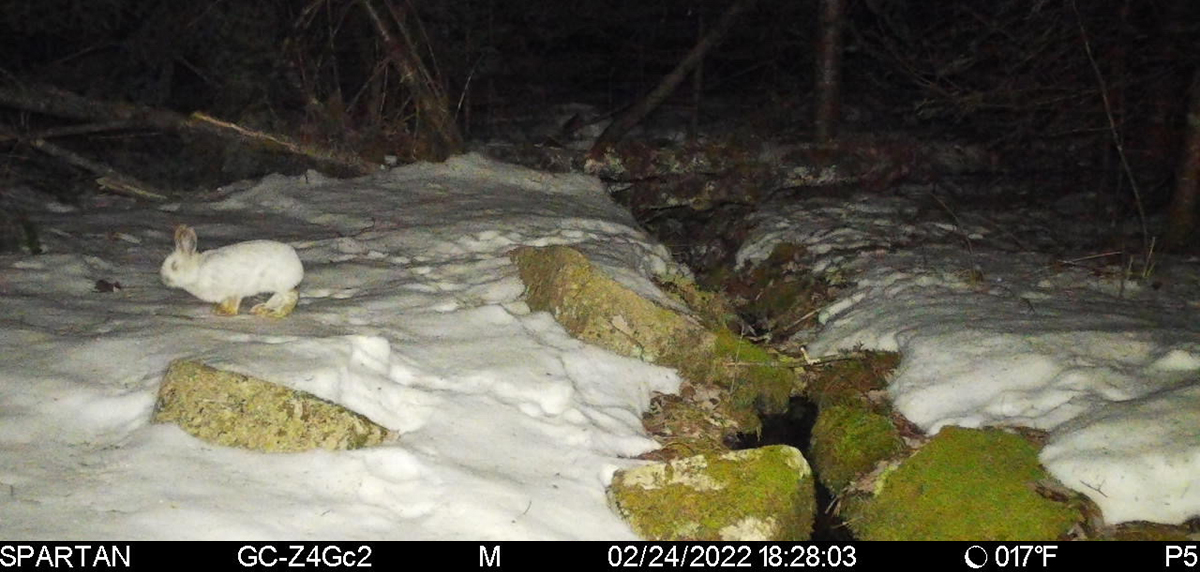What characteristics make a land parcel the perfect candidate for conservation at NEFF?
Writing by NEFF Communications Manager Tinsley Hunsdorfer
When conservation staff members evaluate a forestland for potential protection by New England Forestry Foundation (NEFF), they set out to determine two key things: would protecting the property further any of NEFF’s specific suite of conservation priorities, and is the woodland a good and feasible fit for NEFF?
To answer these questions, conservation staffers embark on a journey to get to know the property, which can involve multiple cross-region road trips to visit and then walk the forestland, phone calls and emails with the landowner, digging up old property deeds, reviewing land surveys, and hoping that no one involved in this process gets stuck in a snow bank if work is ongoing in winter months.
If NEFF decides to move forward with a land protection project once this information is in hand, conservation staffers fill out a formal Land Protection Project Evaluation, which includes a list of NEFF’s nine conservation priorities—goals like, “protect wildlife habitat.” For each priority, staff gives the property a score indicating how much protecting it would further NEFF’s priorities; a high combined score across priorities means the property is a good fit for NEFF’s conservation program and its protection would be in keeping with NEFF’s mission. The evaluation then heads to NEFF’s Board of Directors for review and a vote.
Let’s take a walk through the conservation priorities list—and learn about some remarkable forestlands along the way.
Priority 1: Conserve high-quality, productive forestland that is well suited to forest management
Case Study: Deland Memorial Forest
Protected 1990 | 883 Acres | New Hampshire
While NEFF has seen much growth and change since its 1944 founding, developing and practicing high-standards sustainable forestry—now Exemplary Forestry—on private lands has always been at the heart of NEFF’s work. It therefore seems appropriate that the conservation priority at the top of the list is protecting high-quality and productive working forests.
Deland Memorial Forest—and an adjacent 865 acres protected through 10 NEFF easements and NEFF’s Townes Memorial Forest—earns top marks for this priority thanks to its size and glacial outwash soils, which allow Deland to consistently produce high-quality timber. These soils are well-suited to growing white pine; more than 2.7 million board feet of timber have been harvested from Deland since 2000, and about 85 percent of it was white pine. As noted below, the property’s timber is valuable—unusually so for NEFF lands. NEFF uses harvest income from Deland and other Community Forests to fund NEFF’s work.
As with all NEFF properties managed to Exemplary Forestry standards, Deland’s stocking remains high at more than 20 cords per acre when wetlands are removed from the total acreage count.
Deland’s In-Forest Timber Volume and Value Over Time
- 1982: 5,991 MBF | $418,022 value
- 1990: 6,634 MBF | $678,493 value
- 2001: 9,233 MBF and 12,749 cords | $1,429,118 value
- 2015 (a harvest year): 8,055 MBF and 11,633 cords | $1,529,200 value
MBF: a measurement unit for wood volume equivalent to 1,000 board feet. Wood measured in board feet is of high quality. Cord: a measurement unit for wood volume equivalent to that found in firewood stacked 4’x4’x8’, or 128 cubic feet of wood. One cord equals 1.5 MBF. Wood measured in cords is usually pulp- or pallet-grade.
Priority 2: Protect large, contiguous forested landscapes throughout New England
Case Study: Nichols Memorial Forest
Protected 1981 | 434 Acres | Vermont
Short of protecting an entire landscape in one fell swoop—as NEFF’s Pingree and Downeast Lakes easements did—how does NEFF contribute to conservation on this scale? By prioritizing forests located near or next to other large blocks of conserved land.
Located about 10 miles north of Manchester, NEFF’s Nichols Memorial Forest is bordered by Green Mountain National Forest and Emerald Lake State Park, which means the property is adjacent to about 822,000 additional protected acres of immense ecological and recreational value.
Nichols is certainly a hit with hikers, but its adjacency to these other protected lands has mostly benefited ecosystem health and wildlife. The property supports a vernal pool and deer overwintering habitat likely used by animals who wander in from neighboring lands; its stream is a tributary of the clear and quick-running Otter Creek, which flows into Emerald Lake State Park and then on into the national forest; and a bat hibernacula—an enclosed space where bats overwinter—was located near Nichols as of 2017.
Priority 3: Help private landowners maintain ownership of working forests

John Serafin on his land in Stafford, CT, with NEFF Conservation Easement Manager Andrew Bentley.
Photo by Lisa Hayden
Case Study: Serafin Conservation Easement
Protected 2019 | 365 Acres | Connecticut
This priority only applies to projects where a landowner decides to prevent future development of their property by placing a conservation easement on it, while maintaining ownership. Pingree and Downeast Lakes may be NEFF’s most high-profile easements, but easements are useful for much more than landscape-scale conservation. This includes serving as an estate planning tool that guarantees protection for beloved woodlands after an owner’s death.
NEFF staff saw this process play out in recent years with John Serafin, who for decades had tried to find a way to protect his family’s woodland from development, but was held back by the land survey costs involved. He met up with NEFF representatives in 2015 at an estate planning forum sponsored by the MassConn Woods partnership, and NEFF staff helped him apply for a small grant from the MassConn Regional Conservation Fund that allowed him to move forward with conserving his woodland. Despite some health challenges, John’s goal finally became a reality with the recording of a conservation easement to NEFF in December 2019.
Everyone at NEFF was saddened to learn John had passed away this summer. John’s son David has inherited the property, and he represents the fourth generation to own this beautiful Connecticut forest.
Priority 4: Protect land that adds to existing featured NEFF Community Forests
Case Study: Phelon Memorial Forest
Protected 1973 | 945 Acres | Massachusetts
NEFF expands its featured Community Forests, or its larger Community Forests with amenities like parking and scenic vistas, for a variety of reasons—from a neighboring property owner wanting to sell their land to a trusted conservation organization, to NEFF deciding to help contribute to a wildlife corridor—and in ways that are more cost effective than buying similar acreage as standalone parcels.
As readers will discover on page 11, NEFF’s Phelon Memorial Forest is composed of two donated adjacent properties, the first gifted to NEFF in 1973 and the second in 1984. NEFF’s protection further extends to three easements totaling 740 acres that border Phelon—two owned by Hull Forest Products and one by the Town of Granville—and the nearby 70-acre Clendenin Memorial Forest, donated to NEFF by the Clendenin family in 2019.
Priority 5: Demonstrate Exemplary Forest Management to landowners and local communities
Case Study: Prouty Woods Community Forest
Protected 2003 | 118 Acres | Massachusetts
As all NEFF Community Forests technically serve as demonstration sites for Exemplary Forestry, staffers are looking for one of two things when evaluating a potential forestland for this priority: if it’s easy to access and in a somewhat populous area, or if it’s a large parcel that allows Exemplary Forestry to be demonstrated at scale.
Prouty Woods Community Forest gets top marks for that first option: it’s a forest that’s easy for lots of people to visit, and it’s also well-known thanks to serving as NEFF’s headquarters. Prouty is scheduled to be harvested within the next two years, which presents NEFF with an incredible opportunity to demonstrate Exemplary Forestry.

The view from Prouty Memorial Forest, photo by Charlie Reinertsen
Priority 6: Protect wildlife habitat
Case Study: Pine Knob Conservation Easement
Protected 2016 | 792 Acres | New Hampshire
When evaluating a property for this priority, conservation staffers aren’t just looking for quality habitat—or the potential for future quality habitat—but a quality mix of habitat types that can support a broad range of species. NEFF only sets out to conserve specialty habitat needed by target imperiled wildlife when the critter in question won’t actually live on NEFF land, as with NEFF’s Downeast Community Forests that support healthy salmon populations by filtering and cooling river water.
Maudie and Sumul Shah’s astonishingly beautiful, 800-acre property in northern New Hampshire is a habitat slam-dunk.
Protected by a NEFF easement granted by previous owners Tanya and Dave Tellman, the property is home to a mix of habitat types, including spruce-fir and mixed northern hardwood-conifer forests of different ages, small areas of old-growth northern hardwoods, vernal pools, four small streams, and 130 acres of wetlands in eight complexes—one of them a 28-acre Black Spruce and tamarack wetland complex the Shahs call “The Bog.” These diverse habitat offerings paired with responsible forest management have created quite the wildlife hotspot, which recently prompted a NEFF stewardship staffer to install remote wildlife cams on the property. Wildlife further benefits from an adjacent 180-acre easement also protected by the Tellmans in 2017.
Of the many species Maudie and Sumul have spotted, their favorites include Bobcat, North American Porcupine, American Marten, Snowshoe Hare (pictured above), Long-tailed Weasel in its winter coat, Barred Owl, Broad-winged Hawk, Pileated Woodpecker, Wood Frog, and “lots of interesting insects.”
Learn more about the Shahs’ woodland and wildlife cams in a blog post about their property.

NEFF’s Pine Knob Conservation Easement is home to Snowshoe Hare. Landowner Sumul Shah has photographed a hare in its summer coat, and a hare in its winter coat is shown here in an image captured by a recently installed wildlife cam.
Priority 7: Protect the ecological benefits of forests, including clean water, clean air, clean soil, and carbon sequestration
Case Study: Keene Whitman Memorial Forest
Protected 1996 | 622 Acres | Maine
Similar to priority 5, all NEFF Community Forests—and all NEFF easements as well, in this case—protect forests’ ecological benefits simply by being forestlands under conservation. What gets a NEFF project better marks for this priority? If the forestland in question helps protect these benefits beyond its property lines.
A small, unnamed brook runs through the Keene Whitman Memorial Forest, and it feeds directly into Lake Auburn, which is the water supply for the cities of Auburn and Lewiston. NEFF’s woodland filters and cleans water before it joins the brook and larger watershed, and NEFF ensures responsible management around the brook itself.
Priority 8: Protect the land base in areas with intact forestry infrastructure to support New England’s forest-based industry
Case Study: Merrill Mountain Community Forest
Protected 2019 | 353 Acres | Maine
As an organization that grows, harvests and sells timber, NEFF wants to see New England’s forest-based industries thrive in increasingly climate-smart ways. Supporting these industries also benefits NEFF’s Forest-to-Cities Climate Challenge, which is working to link mass timber buildings in New England with local forests that sustainably generate the wood for them. The region’s forest-based industries and workforces have a critical role to play in this process.
NEFF has a number of properties near some element of forestry infrastructure, but its Merrill Mountain Community Forest falls in a sweet spot. Located in southwestern Maine’s dramatic Hiram Hills, Merrill Mountain primarily features white oak, red oak, and white pine. The property’s location and white pine stands make it a perfect fit for a conservation priority about forestry infrastructure, because long before NEFF received Merrill as a donation from James Donovan, a 2009 NEFF White Pine Heartland initiative identified five select pine mills in the Community Forest’s area, and four are still in business.
With this concentration of mills comes a reliable forester, logger, and trucking workforce that NEFF doesn’t often encounter near other Community Forests.
Priority 9: Provide opportunities for recreation
Case Study: Braintree Mountain Forest
Protected 2013 | 1,547 Acres | Vermont
NEFF has made its commitment to providing outdoor recreation opportunities clear by choosing to call its owned lands Community Forests. They’re meant to be community resources, and are free to visit and open daily from dawn to dusk. So long as visitors follow NEFF guidelines, NEFF permits hiking, snowshoeing, cross-country skiing, trail running, biking, walking leashed dogs, and horseback riding on all its properties; hunting and fishing are permitted at most NEFF properties in accordance with individual state law.
Given that all Community Forests offer recreation options, what does it take for a property to get top marks for this priority? Something unique.
While cross-country skiing is allowed on all NEFF properties, visitors can only ski downhill in one location: Braintree Mountain Forest, which sits in the Braintree Range and includes four peaks. Thanks to a partnership with the Ridgeline Outdoor Collective (ROC), Braintree has trails and glades for backcountry skiing, and a challenging 1,000-foot slope. ROC began working with NEFF in 2014 to develop glades and trails along the peaks’ eastern flanks, and their leadership and volunteers have made sure skiing infrastructure and activity don’t interfere with forest management activities.

The view from Braintree Mountain Forest, photo by Charlie Reinertsen
